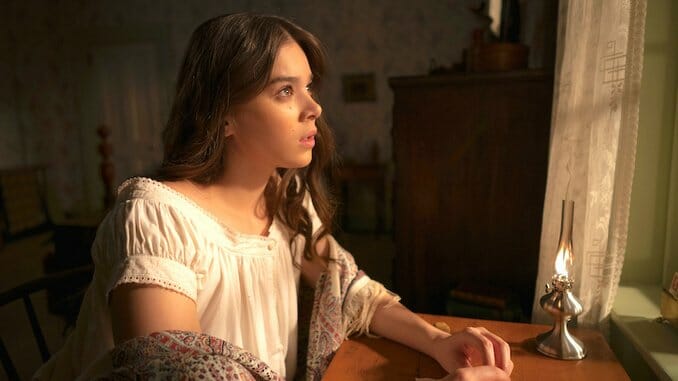Dickinson Season 2: Smarter, Weirder, Warmer, Sexier
In which Emily equates fame with Death, so, you know—relatable.
Photos Courtesy of Apple TV+
“The records of Emily Dickinson’s life, up to and including Sue and Austin’s marriage, are full and factual compared with what lies ahead. Over the next few years, just a handful of letters survive. The truth, perhaps, is hidden in her poems.”
So begins the second season of Alena Smith’s lusciously weird Dickinson, which comes in hot with a trio of new episodes on January 8 before slowing back down to a one-a-week schedule every Friday thereafter. What follows is complete conjecture, it promises its audience, and also, completely True.
This caveat-cum-declaration of capital-T Truth will feel familiar to anyone who’s spent time with Showtime’s The Good Lord Bird, which brings its audience inside the tall-tale exploits of wildman abolitionist John Brown (Ethan Hawke) by way of a pair of title cards that kick each episode off and read simply, “ALL OF THIS IS TRUE” and “MOST OF IT HAPPENED.” Smith’s series—which, not at all incidentally, takes place in the same historical moment as The Good Lord Bird—limits its explicit caveat-making, by contrast, to the first minutes of each season’s first episode, but the very fact of Emily Dickinson as its main character makes for an effect that’s more or less the same. That is to say, regardless of how much of what we see Hailee Steinfeld’s Emily get up to in Season 2 actually happened—obsessing over her entry to the baking contest at Amherst’s annual Cattle Fair? probably; talking to a ghost from the future during a GOOP-y seance led by staff writer/scene stealer Ayo Edibiri? less likely, but not impossible—the emotions the real Emily poured onto paper during this same period are capital-T True enough to make such a question irrelevant.
This, of course, was the thrust of Dickinson’s debut season, whose clever use of anachronism-as-translation I wrote about in my original review. (“It makes unique sense for Dickinson to weave contemporary language, music, and mannerisms into what is otherwise a fairly accurate period piece,” I suggested, “making what might otherwise be foreign about the tensions native to Emily’s daily life unavoidably legible to a modern audience.”) But where the first three episodes of Season 1 made wildly ambitious tonal promises it wasn’t at all clear that the series, as a whole, could keep, the entire run of Season 2 finds every aspect of Emily’s untellable story thriving under Smith and Steinfeld’s vision.
Not only have the musical drops become bolder (Sofi Tukker slotting in comfortably next to Volbeat, Monika Krause, and Cakes Da Killa feat. Rye Rye) and the slangy bits of dialogue more natural (“I’m at all of the balls; I’m a baller” could only ever work in the context of Dickinson), but the dimensions of the period-specific world as it exists beyond Emily’s brain have also deepened. In Season 1, Emily was the melodramatic weirdo gumming up the Dickinsons’ Yankee domestic works; in Season 2, all of the Dickinsons—Adrian Enscoe’s Austin and Anna Baryshnikov’s Lavinia, in particular, but Toby Huss and Jane Krakowski as Mr. and Mrs. Dickinson, too—are given room to be just as weird and prone to flights of supernatural fancy as Emily is. This makes for some especially fun individual scenes (the payoff to Lavinia’s obsession with Lola Montez is *chef’s kiss*, as is Austin’s big-hearted moral growth), but it also gives Emily’s mysteriously hermetic life a real sense of cohesion. So much of the mystery that is Emily Dickinson lies in how she sustained such a rich emotional life while spending so much of it locked behind the door of her childhood bedroom; with a family as warm and idiosyncratic as the one Smith et al give her in Season 2, one possible answer to that mystery feels a lot clearer.
It’s not just the emotional worlds of Emily’s friends and family that are given space to breathe in Season 2, either. In introducing Finn Jones as the tech-bro newspaperman Samuel Bowles and Will Pullen as a nobody-ghost who won’t leave Emily alone—and in expanding the roles of Austin’s servants Henry (Chinaza Uche) and Hattie (Ayo Edibiri) as members of a group of Black Amherstians who, with Austin’s help, print an abolitionist newspaper out of the Dickinsons’ barn—the series makes room for a complex (if still funny and/or poetic!) examination of the political landscape in which Emily worked and dreamed. More complex, at least, than one might expect from a series that so superficially delights in framing Sue (Ella Hunt) as an “influencer,” or making Lavinia obsessed with the healing power of crystals, or stunt-casting Nick Kroll as the horny ghost of Edgar Allen Poe. That it all happens on the eve of John Brown’s failed raid on Harpers Ferry (those Good Lord Bird vibes are real) is especially resonant. The social and political landscape in which Emily lived was the most fraught (well, TBD) in American history; being honest about that matters. Thankfully, with a creative team helmed by Smith and including writers like Edibiri, Yael Green, Sophie Zucker, Ken Greller and R. Eric Thomas, that honesty is also deeply funny.